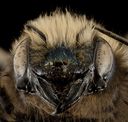Hornfaced Bee
Osmia cornifrons
Classification
- Phylum: Arthropoda
- Subphylum: Hexapoda
- Class: Insecta
- Order: Hymenoptera
- Family: Megachilidae
- Subfamily: Megachilinae
- Tribe: Osmiini
- Genus: Osmia
- Species: cornifrons
Pronunciation
How to pronounce Osmia cornifrons: //ˈɒs.mi.ə kɔːrˈni.frɔːnz//
These audio files are automatically generated. While they are not always 100% accurate, they are a good starting point.
Images






Summary
Osmia cornifrons, or the hornfaced bee, is a solitary species effective in pollinating flowers, particularly apple crops, known for its characteristic facial extensions and introduced to North America for agricultural purposes.
Physical Characteristics
Osmia cornifrons is recognized for its horn-like extensions originating from its lower face and is characterized as a solitary bee.
Identification Tips
Look for the horn-like facial extensions which are a distinguishing feature of this species.
Habitat
Prefers humid environments and nests in bamboo, reeds, and existing holes in trees, but can also function in cooler environments.
Distribution
Native to East Asia, primarily found in Japan, Korea, China, and Russia; widely introduced and established in eastern North America.
Diet
Primarily feeds on pollen and nectar from a variety of flowers, showing high flower constancy.
Life Cycle
Life cycles consist of six stages: spring incubation, pre-nesting, nesting, development, prewintering, and wintering. Development is affected by temperature, with emergence correlating closely to crop flowering periods.
Reproduction
Females can lay up to 30 eggs in their lifetime, utilizing haplodiploid sex determination to control offspring sex ratio. Males are haploid, while females are diploid.
Predators
Populations are affected by parasitic mites, particularly Chaetodactylus nipponicus, Chaetodactylus hirashimai, and Chaetodactylus krombeini, the last of which has a significant negative impact on productivity.
Ecosystem Role
Essential pollinators for fruit crops, particularly apple, recognized for their effectiveness and speed in pollination.
Economic Impact
Introduced for crop pollination, particularly effective in increasing fruit yield in orchards.
Cultural Significance
Utilized in Japan for apple tree pollination; introduced to North America for similar agricultural benefits.
Misconceptions
Often confused with the native species Osmia lignaria, which has similar management practices for pollination.
Tags
- pollinator
- solitary bee
- Osmia cornifrons
- Hymenoptera
- introduced species
- crop pollination